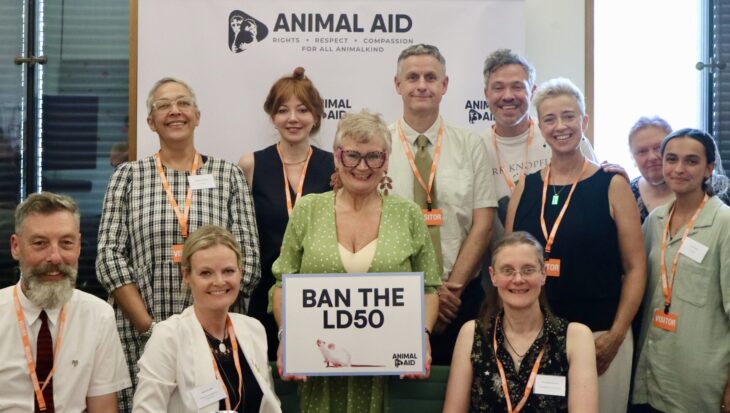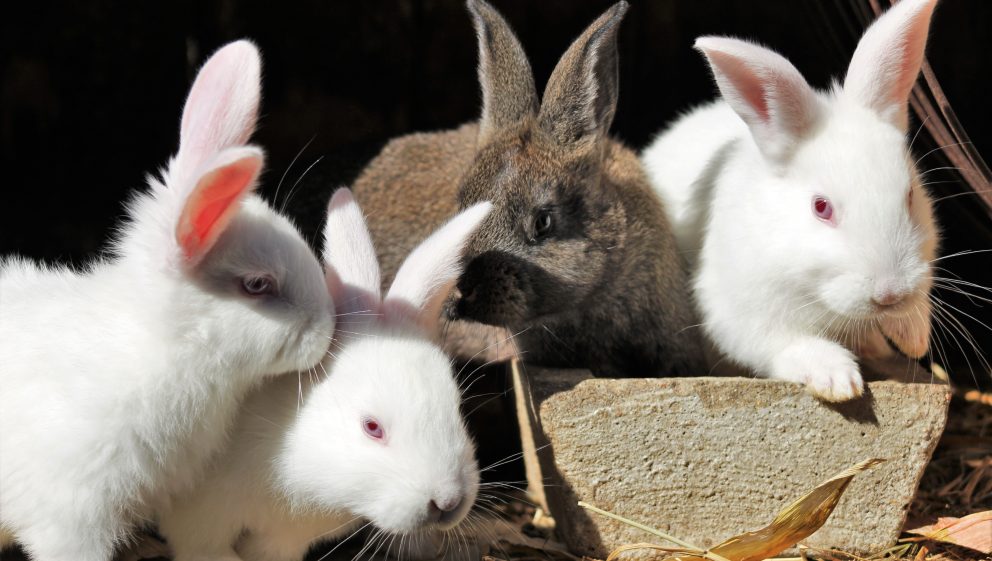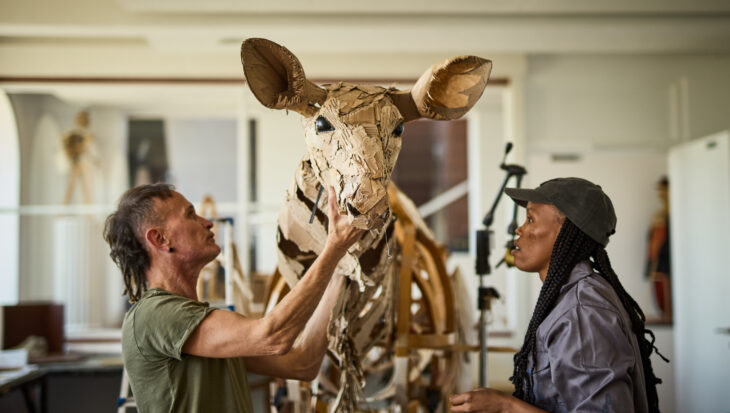Animal Aid in parliament to discuss ending animal tests
Yesterday, Animal Aid hosted a roundtable in Westminster, to meet with MPs and other invited guests to discuss the ending the LD50 and other animal tests.
Posted 02 Jul 2025

Posted on the 3rd March 2021
An application has been put forward by T&S Nurseries, a rabbit farm 'franchiser', to get planning permission granted for the setting up of a 250 female rabbit breeding and rearing operation to produce upwards of 10,000 rabbits per year. They previously created public outrage by trying to set up rabbit battery cage farming systems across the UK. It is clear that the motivation is certainly not animal welfare but instead profit.

Update: Plans for a rabbit farm in Amersham, Buckinghamshire were refused by Buckinghamshire Council following a sustained national campaign. Hundreds of objections were submitted while 87,901 people signed the Change.org petition – thank you for making this happen!
You can object via email to: planning.comments.csb@buckinghamshire.gov.uk
Include the Planning Application Number: PL/21/0130/FA
Address: Land at Magpie Lane Amersham Road Coleshill Buckinghamshire.
The plans are available to view on this webpage: https://pa.chilternandsouthbucks.gov.uk/online-applications/applicationDetails.do?keyVal=QMVHFFESGQV00&activeTab=summary
Please add your full name and postal address in order for it to be valid.
It is also an opportunity to ask for welfare to be made a material consideration during the review of planning permission applications involving animals.
Unfortunately, moral objections or animal welfare do not hold weight in the planning process, but that doesn’t mean that you shouldn’t voice your thoughts in passing. Feel free to elaborate upon the following points in your objection.
Rabbit welfare issues you may like to draw attention to in passing
-Grave concerns for the welfare of the rabbits to be farmed as there is no substantial species-specific legislation protecting the welfare of rabbits in the UK.
– Rabbits are a prey species, and therefore inclined to hide signs of illness if unwell. Because of this, rabbits can be extremely ill before those caring for them even notice. Without specific rabbit knowledge, many animals may just suffer in silence and die without medical intervention.
– Rabbits need to be carefully introduced and bonded in pairs or small groups to avoid any territorial issues and fighting.
– Artificial insemination is common practice on rabbit farms. Female rabbits (does) may be held on their backs against their will throughout the process, causing them severe stress, and potentially injury, through poor handling and restraint. Rabbits are prey animals and being on their backs is terrifying for them.
– Does may be kept caged for their whole lives and their bodies can become exhausted from the strain of repeated forced pregnancies. They are often slaughtered after just three years. For comparison, domesticated rabbits can live on average of 10 years.
– Young rabbits bred to be exploited for their meat are killed at on average between 16 weeks old, a fraction of their natural lifespan.
Public attitudes to rabbit meat and real fur
– We understand that fur would likely be produced as a ‘by-product’ which is highly distasteful and ‘fur farming by the back door’: http://www.tandsrabbits.co.uk/products.html
– There is huge public sentiment against real fur in the UK. A recent YouGov poll by Humane Society International revealed that the vast majority (93%) of people in Britain don’t wear real animal fur and do support a #FurFreeBritain. https://www.hsi.org/news-media/yougov-poll-reveals-vast-majority-of-brits-support-furfreebritain/
– There is little demand for rabbit meat in the UK, and most people are repulsed at the thought of consuming it. Rabbits are mostly viewed as companion or wild animals in the UK. The farm, should it set up, could attract protests and unwanted attention, disrupting local life.
Rabbits as potential SARS-CoV-2 reservoirs
‘A new study by scientists in the Netherlands in August 2020 shows that the severe acute respiratory coronavirus-2 (SARS-CoV-2) can infect rabbits, which opens the door for possible circulation in rabbit farms and another potential source of animal to human SARS-CoV-2 infection.’ https://www.news-medical.net/news/20200830/Rabbits-susceptible-to-SARS-CoV-2-Red-flag-for-potential-virus-reservoir.aspx
– The proposed type of farming is unacceptable especially in the middle of a pandemic caused by an animal-to-human virus along with new variants now emerging, and this should be taken into serious consideration. The fact that rabbits can be infected with covid could potentially make this a reservoir for the virus.
Disease management
– There are no measures outlined on how they intend to combat the spread of disease in the rabbits. There are no specific drugs licensed for use in ‘meat’ rabbits in the UK, due in a large part to the lack of commercial rabbit farming here. There is no mention of vaccinating the rabbits against the fatal, incurable diseases myxomatosis, VHD and VHD2. There is a concern that disease could pass between wild rabbits and unvaccinated companion rabbits in the vicinity. These diseases are lethal and easily spread between rabbit populations. Many pet rabbits are vaccinated, but many are not, and there is no vaccination programme for wild rabbits.
– There is a risk of outbreaks of coccidiosis if rabbits are kept in very hygienic conditions with regular cleaning of housing and pens. The rabbits would need to be circulated on range and the ground left fallow for suitable stretches of time. We question how this may be achieved with hundreds if not thousands of rabbits and in the presence of wild rabbits. Here is some further information about this: https://netvet.co.uk/rabbits/coccidiosis/
Road safety
Magpie Lane is said by local residents to be a busy road, and there is a carpark exit directly opposite to the site which could cause safety issues. There has already been a petition calling for traffic calming measures on this stretch of road in order to protect walkers, bikers, alpacas, horses and horse riders.
Foul odour and noise
– The site is located just across the road from houses and a public house. The noise and smell generated from the site could be disruptive to local life. Farming hundreds or even thousands of rabbits on such an intensive scale will undoubtedly produce a great amount of waste and therefore foul odours. This could also lead to flies.
Green Belt land
The proposed location is on Green Belt land. The space as it stands provides individuals with opportunities for healthy physical exercise in the countryside. This also acts as nature habitat. It is vital that air quality is safeguarded.
Area of Outstanding ‘Natural Beauty (AONB)
The area is also considered an Area of Outstanding Natural Beauty (AONB). The adopted Local Plan states ‘The natural beauty of much of the district’s countryside is of great importance to the quality of the life enjoyed by residents and visitors and so must be protected.’ https://www.chilternsaonb.org/uploads/files/ConservationBoard/ManagementPlan/Management%20Plan%202014-19/chilterns_management_plan_2014-19_final.pdf
Site of Special Scientific Interest (SSSI) within 500m
– The proposed location is near a Site of Special Scientific Interest (SSSI) to the South, Hodgemoor Wood. We are concerned about the waste run-off from the proposed site.
How do the applicants intend to stop waste run-off from the large amount of waste that the rabbits shall create on the land from polluting the SSSI.
Wildlife
-A preliminary protected species survey appears to reveal the presence of water vole, badger, hazel dormouse, Natterer’s bat, Brown-eared bat and crested newt as well as the presence of 119 bird species within 2km of the site. Nests were noted in mature trees which are suitable for large as well as small bird species to nest in. At a time when we must be doing all we can to protect what little wildlife remains, further encroaching on the little habitat that they have left is the wrong direction of travel.
– There is also a concern for rabbits escaping into the local environment and disturbing the local ecosystem. Rabbits are exceptional diggers and are adept escape artists through tunnelling out.
– A rabbit farm would attract wildlife such as foxes and badgers, and possibly domestic dogs, threatening local conservation efforts. The ‘management’ of predatory species such as foxes may lead to even more cruelty.
– There would need to be a strong perimeter fence and overhead mesh to prevent predation of young rabbits by birds of prey. This would create quite a blot on the landscape.
Slaughter of rabbits and waste
– There is no mention of how the rabbits shall be slaughtered or of how biological waste will be dealt with more widely. If they are to be a ‘small scale producer’ ie ‘producing’ no more than 10,000 rabbits a year, then they may plan to slaughter the rabbits on site. There is nothing in the proposal outlining how waste from this process shall be disposed of, nor how it will be ensured that none of this waste will contaminate the surrounding area.
– If they plan to send the rabbits off site, then there will be a number of additional vehicle movements.
-Approximately every 16 weeks, each ‘batch’ of rabbits would be sold on or killed.
Waste and pollution
– Each individual pen will need to be poo-picked and individual hutches regularly cleaned and disinfected. How will all the waste be dealt with? This will all need to be collected, creating more vehicle movements. We question what will happen to the nitrate-rich waste run-off from the farm.
Temporary rural workers’ dwelling
-It is unclear within the proposal about the anticipated timescales for the temporary residence for workers. This could span months or years, and this may just be a ‘foot through the door’ and a permanent house structure may be applied for next, further and permanently blighting the landscape. This is something that needs to be known to make a fully informed decision on this application.
It is so important to lodge as many written objections as possible, so please take a moment to place an objection in your own words.
The same ‘franchiser’ has submitted plans for a similar system in Cornwall – take action here
Yesterday, Animal Aid hosted a roundtable in Westminster, to meet with MPs and other invited guests to discuss the ending the LD50 and other animal tests.
Posted 02 Jul 2025

Have you heard? A breathtaking arts initiative, ‘The Herds’ will be arriving in London this Friday.
Posted 27 Jun 2025
